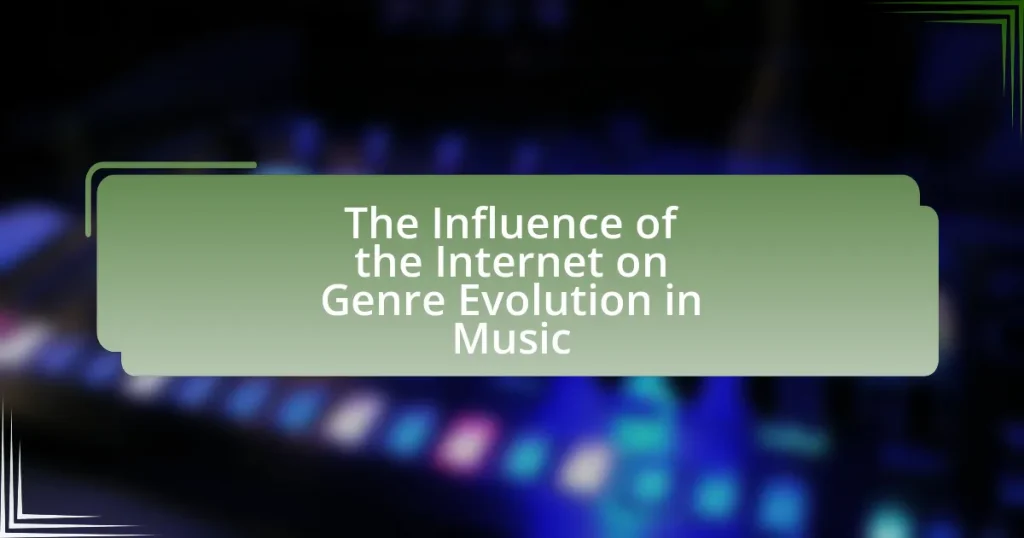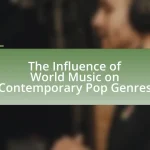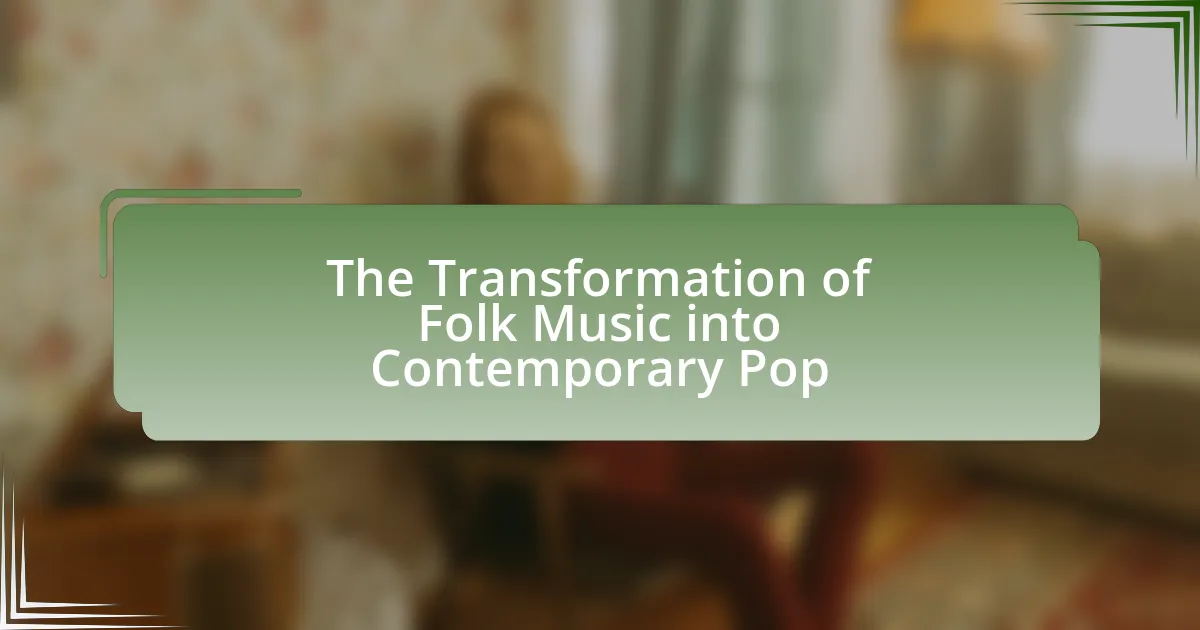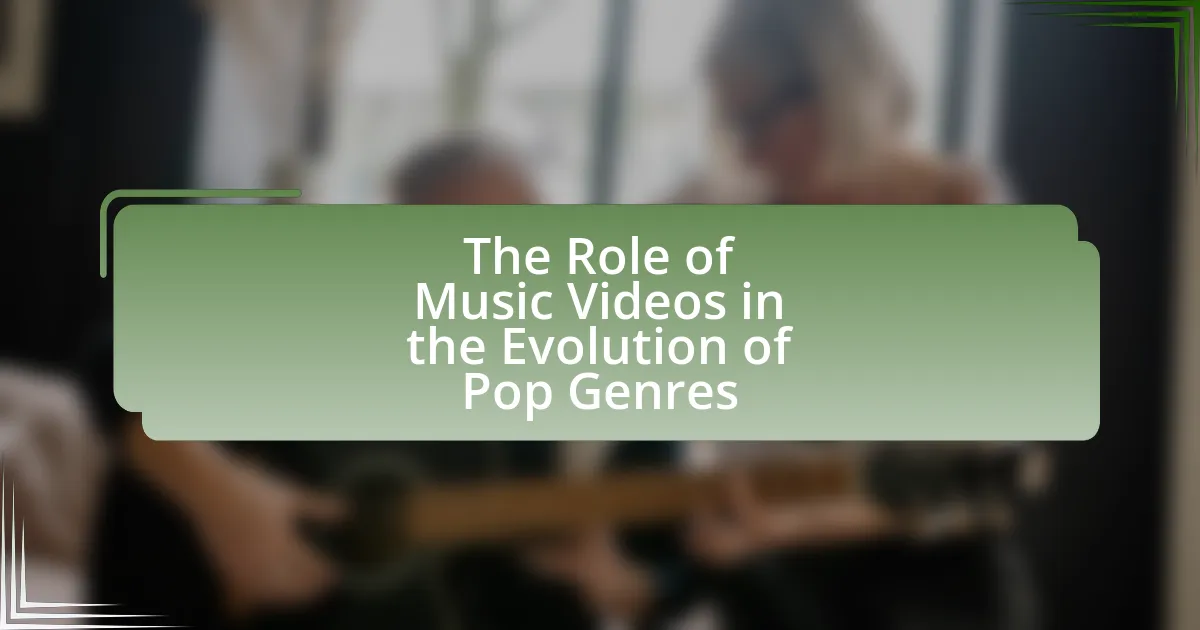The article examines the significant influence of the Internet on the evolution of music genres. It highlights how online platforms facilitate the rapid dissemination and blending of diverse musical styles, leading to the emergence of new genres and subgenres. Key factors driving this evolution include accessibility, collaboration, and audience engagement, with streaming services and social media playing crucial roles in genre classification and discovery. The article also discusses the impact of viral trends, digital distribution, and the challenges posed to traditional genre boundaries, emphasizing the Internet’s transformative effect on music production and consumption.
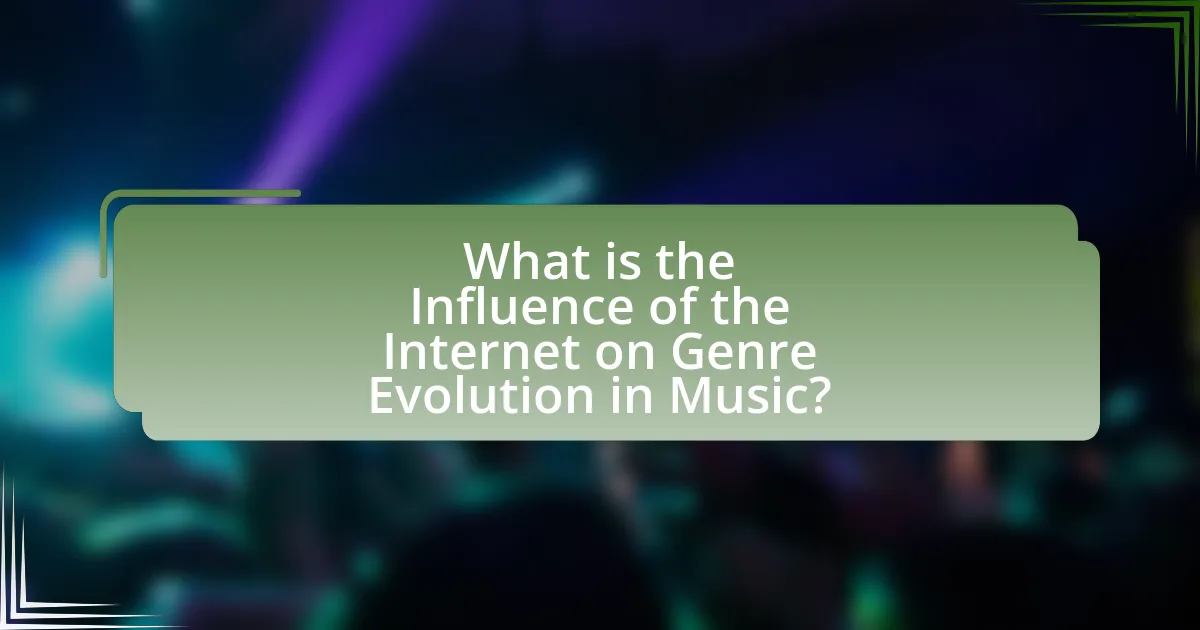
What is the Influence of the Internet on Genre Evolution in Music?
The Internet significantly influences genre evolution in music by facilitating the rapid dissemination of diverse musical styles and enabling collaboration across geographical boundaries. This connectivity allows artists to access a vast array of influences, leading to the fusion of genres, such as the blending of hip-hop with electronic music, which has gained popularity through platforms like SoundCloud and YouTube. Furthermore, data from the International Federation of the Phonographic Industry (IFPI) indicates that streaming services have transformed how listeners discover and consume music, promoting niche genres that may have previously struggled for visibility. This democratization of music distribution has resulted in the emergence of new genres and subgenres, reflecting a more globalized musical landscape.
How has the Internet changed the way music genres are defined?
The Internet has fundamentally altered the definition of music genres by enabling the rapid dissemination and blending of diverse musical styles. This shift is evident in the rise of subgenres and hybrid genres, as artists can easily access and incorporate influences from around the world, leading to the creation of unique sounds that defy traditional genre boundaries. For instance, the emergence of genres like lo-fi hip hop and trap music showcases how online platforms facilitate genre fusion, allowing artists to experiment and reach global audiences. Additionally, streaming services and social media have democratized music distribution, allowing independent artists to define their own genres without the constraints of traditional music industry classifications. This has resulted in a more fluid and dynamic understanding of music genres, reflecting the diverse tastes and cultural influences present in the digital age.
What role do online platforms play in genre classification?
Online platforms play a crucial role in genre classification by facilitating the categorization and discovery of music through user-generated content and algorithmic recommendations. These platforms, such as Spotify and YouTube, utilize metadata, user interactions, and listening habits to classify music into genres, making it easier for listeners to find and explore new music. For instance, Spotify’s algorithm analyzes millions of playlists and user preferences to create genre-specific playlists, which influences how genres are perceived and evolve over time. This data-driven approach not only helps in organizing music but also reflects shifting trends in listener preferences, thereby impacting the overall landscape of music genres.
How do user-generated content and social media influence genre perception?
User-generated content and social media significantly influence genre perception by democratizing music distribution and enabling diverse audience engagement. Platforms like YouTube and TikTok allow users to share their interpretations and remixes, which can reshape how genres are understood and categorized. For instance, the viral success of songs on TikTok often leads to the emergence of new sub-genres, as seen with the rise of “bedroom pop,” where artists like Clairo gained popularity through social media exposure. This shift illustrates how user-generated content can challenge traditional genre boundaries and create new cultural narratives around music.
Why is the Internet significant in the evolution of music genres?
The Internet is significant in the evolution of music genres because it facilitates unprecedented access to diverse musical styles and global collaboration among artists. This accessibility allows listeners to discover and share a wide range of genres, leading to the blending and emergence of new styles. For instance, platforms like Spotify and YouTube enable users to explore niche genres that may not have received mainstream attention, thus fostering genre hybridity. Additionally, the rise of social media has empowered independent artists to reach audiences directly, bypassing traditional gatekeepers in the music industry. This democratization of music distribution has resulted in the rapid evolution of genres, as seen with the rise of genres like lo-fi hip hop and bedroom pop, which gained popularity through online communities and streaming services.
What historical shifts in music genres can be attributed to the Internet?
The Internet has significantly shifted music genres by facilitating the rise of digital distribution, leading to the emergence of new genres and the blending of existing ones. For instance, the accessibility of platforms like SoundCloud and Bandcamp has allowed independent artists to share their work globally, resulting in the popularization of genres such as lo-fi hip-hop and bedroom pop. Additionally, the Internet has enabled the fusion of diverse musical styles, exemplified by the rise of genres like trap, which combines elements of hip-hop, electronic, and pop music. According to a 2020 report by the International Federation of the Phonographic Industry, over 70% of music consumption now occurs through streaming services, highlighting the Internet’s role in reshaping listener preferences and genre popularity.
How does the Internet facilitate genre blending and hybridization?
The Internet facilitates genre blending and hybridization by providing a global platform for artists to share and collaborate across diverse musical styles. This connectivity allows musicians from different backgrounds to experiment with various genres, leading to innovative combinations such as pop-rap or country-electronic. For instance, platforms like SoundCloud and YouTube enable independent artists to reach audiences worldwide, fostering cross-genre collaborations that might not occur in traditional music industry settings. Additionally, algorithms on streaming services like Spotify promote genre-blending by recommending tracks that mix different styles, further encouraging listeners to explore hybrid genres. This dynamic environment has resulted in the emergence of new musical forms, reflecting the diverse influences available online.
What are the key factors driving genre evolution through the Internet?
The key factors driving genre evolution through the Internet include accessibility, collaboration, and audience engagement. Accessibility allows artists to distribute their music globally without traditional gatekeepers, leading to the emergence of diverse genres. Collaboration is facilitated by online platforms, enabling musicians from different backgrounds to create hybrid genres, as seen in the rise of genres like trap and lo-fi. Audience engagement through social media and streaming services allows listeners to influence trends and discover new sounds, further accelerating genre evolution. For instance, platforms like SoundCloud have been instrumental in popularizing sub-genres by providing a space for independent artists to share their work directly with fans.
How do streaming services impact genre popularity and accessibility?
Streaming services significantly enhance genre popularity and accessibility by providing vast libraries of music that cater to diverse tastes. These platforms, such as Spotify and Apple Music, utilize algorithms to recommend songs and artists, which exposes listeners to a wider range of genres than traditional radio or physical media. For instance, a report by the International Federation of the Phonographic Industry (IFPI) in 2021 indicated that streaming accounted for 62.1% of global recorded music revenue, demonstrating its central role in music consumption. Additionally, the ease of access to niche genres allows artists from various backgrounds to reach global audiences, thereby increasing the visibility and popularity of genres that may have previously been marginalized.
What influence do algorithms and playlists have on genre discovery?
Algorithms and playlists significantly enhance genre discovery by personalizing music recommendations based on user preferences and listening habits. Streaming platforms like Spotify and Apple Music utilize complex algorithms that analyze user data, such as song skips, likes, and listening duration, to curate playlists that introduce listeners to new genres they may not have explored otherwise. For instance, Spotify’s “Discover Weekly” playlist has been shown to increase exposure to diverse genres, leading to a broader understanding and appreciation of different musical styles. This data-driven approach not only helps users discover niche genres but also influences the popularity and evolution of those genres in the music industry.
How does the Internet foster collaboration among artists across genres?
The Internet fosters collaboration among artists across genres by providing platforms for communication, sharing, and co-creation. Artists can connect through social media, collaborative tools, and online communities, enabling them to exchange ideas and work together regardless of geographical barriers. For instance, platforms like SoundCloud and Bandcamp allow musicians to share their work and collaborate on projects, leading to genre-blending and innovative musical styles. Additionally, tools such as Google Drive and collaborative software like Splice facilitate real-time collaboration, allowing artists to contribute to each other’s projects seamlessly. This interconnectedness has resulted in a significant increase in cross-genre collaborations, as evidenced by the rise of genre fusion in contemporary music, where artists from different backgrounds create unique sounds together.
What challenges does the Internet pose to traditional music genre boundaries?
The Internet challenges traditional music genre boundaries by facilitating the blending and cross-pollination of diverse musical styles. This digital platform allows artists to easily share and access a wide range of genres, leading to the emergence of hybrid genres that defy conventional classifications. For instance, the rise of genres like trap, which incorporates elements of hip-hop, electronic, and pop, exemplifies how the Internet enables artists to experiment beyond traditional confines. Additionally, streaming services and social media platforms promote algorithm-driven recommendations that expose listeners to a variety of music, further blurring genre lines. This accessibility and exposure contribute to a more fluid understanding of music genres, making it difficult to categorize music strictly based on historical definitions.
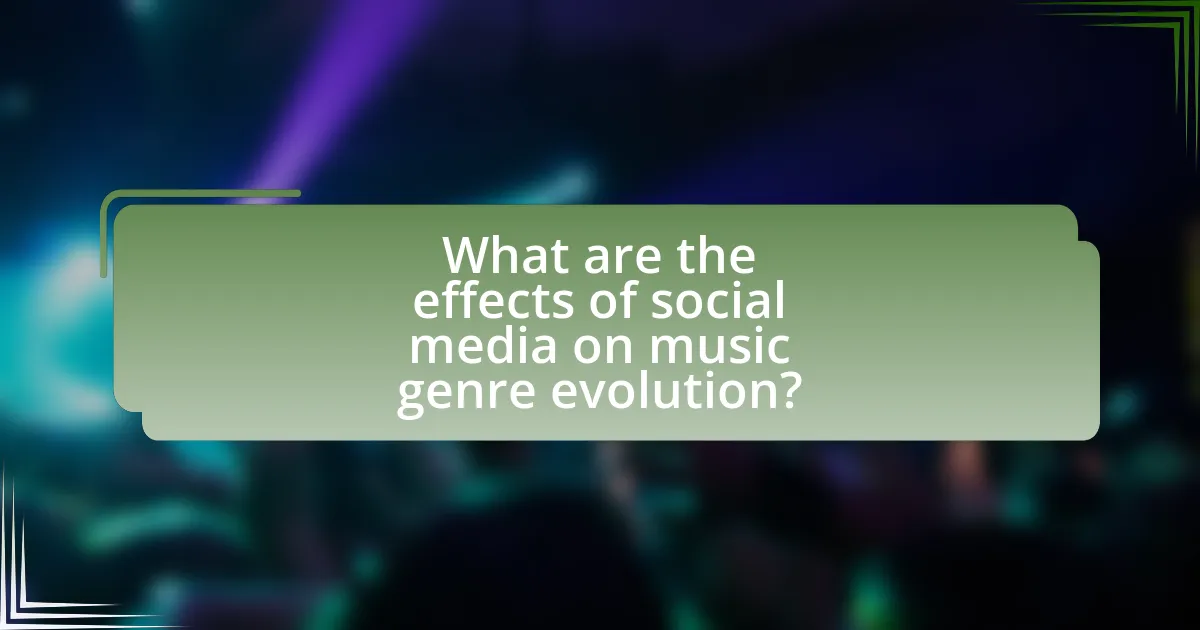
What are the effects of social media on music genre evolution?
Social media significantly influences music genre evolution by facilitating the rapid dissemination of diverse musical styles and enabling direct artist-fan interactions. Platforms like Spotify, YouTube, and TikTok allow emerging genres to gain visibility and traction, often leading to the blending of styles, as seen with the rise of genres like lo-fi hip hop and trap. For instance, TikTok’s viral trends have propelled songs across various genres into mainstream popularity, showcasing how user-generated content can shape musical tastes and trends. This democratization of music distribution allows for niche genres to flourish, as artists can reach global audiences without traditional gatekeepers, thereby accelerating the evolution of music genres.
How do social media platforms shape music trends and genres?
Social media platforms shape music trends and genres by facilitating rapid dissemination and discovery of new music, allowing artists to reach wider audiences and engage directly with fans. For instance, platforms like TikTok have propelled songs to viral status, influencing genre popularity and trends; the song “Old Town Road” by Lil Nas X gained immense popularity through TikTok, leading to its crossover success in multiple genres. Additionally, algorithms on platforms such as Spotify and YouTube curate personalized music recommendations, which can introduce listeners to emerging genres and artists, further shaping musical tastes and trends.
What role do influencers play in promoting specific music genres?
Influencers play a crucial role in promoting specific music genres by leveraging their large followings to introduce and popularize new sounds and artists. They often curate playlists, share music-related content, and engage with their audiences through social media platforms, which can significantly increase the visibility of particular genres. For instance, influencers on platforms like TikTok have been known to propel songs into viral status, leading to increased streaming and chart success. This phenomenon is supported by data showing that tracks featured in viral challenges or trends can see a 1,000% increase in streams within days, demonstrating the direct impact influencers have on music genre promotion.
How does audience engagement on social media affect genre popularity?
Audience engagement on social media significantly boosts genre popularity by facilitating direct interaction between artists and fans, leading to increased visibility and sharing of music. When audiences actively engage through likes, shares, and comments, they amplify the reach of specific genres, making them more mainstream. For instance, data from a 2021 report by the International Federation of the Phonographic Industry (IFPI) indicated that social media platforms are crucial for music discovery, with 70% of listeners using these platforms to find new music. This engagement not only promotes individual songs but also elevates entire genres, as trends often emerge from viral content shared across social networks.
What are the implications of viral trends on music genres?
Viral trends significantly influence music genres by accelerating their evolution and reshaping listener preferences. For instance, the rise of platforms like TikTok has led to the rapid popularity of specific genres, such as lo-fi hip-hop and hyperpop, as songs that go viral often incorporate catchy hooks and relatable themes. Data from the 2021 IFPI Global Music Report indicates that streaming platforms have transformed how music is consumed, with viral hits often leading to increased sales and streaming numbers for entire genres. This phenomenon demonstrates that viral trends can create new subgenres or revive older ones, as seen with the resurgence of 80s synth-pop elements in contemporary music.
How do viral challenges and memes influence genre exposure?
Viral challenges and memes significantly enhance genre exposure by rapidly disseminating music across diverse audiences through social media platforms. These challenges often incorporate specific songs or genres, leading to increased visibility and engagement. For instance, the TikTok platform has been instrumental in popularizing songs like “Old Town Road” by Lil Nas X, which gained traction through a viral dance challenge, resulting in the song topping the Billboard charts for a record-breaking 19 weeks. This phenomenon illustrates how memes and challenges can create a direct link between user-generated content and music consumption, effectively introducing listeners to genres they may not have explored otherwise.
What are the long-term effects of viral trends on genre sustainability?
Viral trends can significantly impact genre sustainability by altering listener preferences and market dynamics. When a trend goes viral, it often leads to a temporary surge in popularity for a specific genre, which can overshadow traditional or less popular genres. This shift can result in a reallocation of resources, such as marketing and production, towards the trending genre, potentially marginalizing others. For instance, the rise of genres like trap and lo-fi hip-hop, driven by viral social media platforms, has reshaped the music landscape, leading to increased investment in these styles while older genres may struggle to maintain relevance. Additionally, the rapid consumption of music through streaming services, influenced by viral trends, can create a cycle where only the most commercially viable genres receive sustained attention, ultimately threatening the diversity and longevity of the music ecosystem.
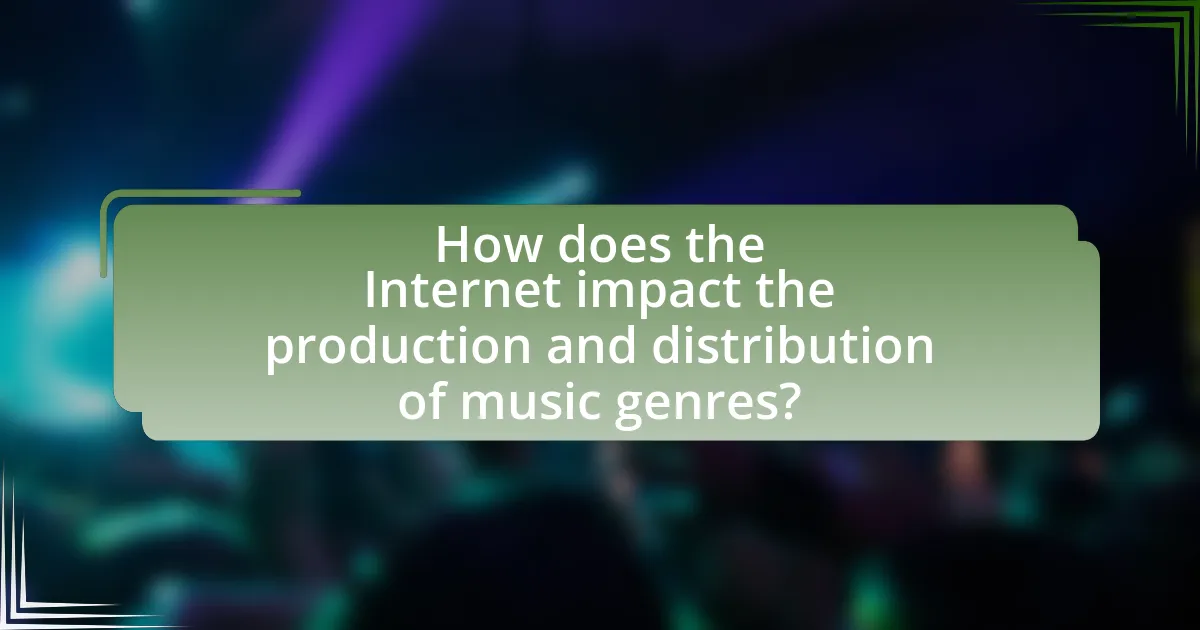
How does the Internet impact the production and distribution of music genres?
The Internet significantly impacts the production and distribution of music genres by enabling independent artists to create, share, and promote their work without traditional gatekeepers. This democratization of music production allows for diverse genres to emerge and flourish, as platforms like SoundCloud and Bandcamp provide accessible tools for artists to reach global audiences. According to a 2021 report by the International Federation of the Phonographic Industry, over 60% of music consumption now occurs through streaming services, illustrating how the Internet has transformed distribution methods and consumer access to various genres. Additionally, social media platforms facilitate viral marketing, allowing niche genres to gain traction rapidly, further influencing the evolution of music styles.
What changes in music production have emerged due to the Internet?
The Internet has significantly transformed music production by democratizing access to tools and platforms, allowing independent artists to create and distribute music without traditional gatekeepers. This shift has led to the rise of digital audio workstations (DAWs) and online collaboration tools, enabling musicians to produce high-quality recordings from home studios. Additionally, the Internet has facilitated the emergence of platforms like SoundCloud and Bandcamp, which allow artists to share their work directly with audiences, bypassing record labels. According to a 2020 report by the International Federation of the Phonographic Industry, over 40% of music consumption now occurs through streaming services, highlighting the Internet’s role in reshaping how music is produced and consumed.
How do digital tools and software influence genre creation?
Digital tools and software significantly influence genre creation by enabling artists to experiment with sounds and production techniques that were previously inaccessible. These tools, such as digital audio workstations (DAWs), synthesizers, and sampling software, allow musicians to blend genres and create new styles by manipulating audio in innovative ways. For instance, the rise of DAWs like Ableton Live and FL Studio has democratized music production, allowing independent artists to produce high-quality tracks without the need for expensive studio time. This accessibility has led to the emergence of hybrid genres, such as lo-fi hip-hop and electronic pop, which combine elements from various musical traditions. Furthermore, platforms like SoundCloud and Bandcamp facilitate the sharing of these new genres, fostering communities that encourage genre experimentation and evolution.
What is the role of home studios in genre diversification?
Home studios play a crucial role in genre diversification by providing accessible platforms for artists to experiment with various musical styles without the constraints of traditional recording environments. This accessibility allows musicians to blend genres, leading to innovative sounds and the emergence of new subgenres. For instance, the rise of home recording technology has facilitated the creation of genres like lo-fi hip-hop and bedroom pop, which thrive on DIY aesthetics and personal expression. The proliferation of digital audio workstations and affordable recording equipment has empowered independent artists to produce and distribute their music globally, further contributing to the diversification of musical genres.
How has music distribution evolved with the rise of the Internet?
Music distribution has transformed significantly with the rise of the Internet, shifting from physical formats to digital platforms. In the late 1990s, the emergence of file-sharing services like Napster disrupted traditional distribution models, allowing users to share music freely, which led to a decline in CD sales. By the early 2000s, digital downloads became prevalent, with platforms like iTunes enabling consumers to purchase individual tracks legally. The introduction of streaming services such as Spotify and Apple Music in the 2010s further revolutionized distribution by providing access to vast libraries of music for a subscription fee or ad-supported model, fundamentally changing how artists monetize their work and how listeners consume music. According to the Recording Industry Association of America (RIAA), streaming accounted for over 80% of the music industry’s revenue by 2020, illustrating the dominance of digital distribution in contemporary music consumption.
What are the advantages of digital distribution for emerging genres?
Digital distribution offers significant advantages for emerging genres by providing wider accessibility and reducing barriers to entry. This model allows independent artists to reach global audiences without the need for traditional record labels, which often impose restrictive contracts. For instance, platforms like Spotify and Bandcamp enable artists to upload their music directly, facilitating exposure to diverse listener bases. Additionally, digital distribution allows for real-time feedback and data analytics, helping artists understand audience preferences and adapt their music accordingly. According to a 2021 report by the International Federation of the Phonographic Industry, digital music revenues accounted for 62% of the global recorded music market, underscoring the importance of digital platforms in promoting new genres.
How do independent artists leverage the Internet for genre promotion?
Independent artists leverage the Internet for genre promotion by utilizing social media platforms, streaming services, and digital marketing strategies to reach wider audiences. These artists create and share content on platforms like Instagram, TikTok, and YouTube, which allows them to engage directly with fans and showcase their unique sound. For instance, TikTok has become a significant tool for music discovery, with viral trends leading to increased streams and downloads. Additionally, independent artists often distribute their music through platforms like Bandcamp and Spotify, which provide access to global audiences without the need for traditional record labels. According to a 2021 report by the International Federation of the Phonographic Industry, independent music accounted for 40% of global recorded music revenue, highlighting the effectiveness of these online strategies in promoting diverse genres.
What best practices can artists adopt to navigate genre evolution in the digital age?
Artists can adopt several best practices to navigate genre evolution in the digital age, including embracing collaboration, leveraging data analytics, and maintaining a flexible creative approach. Collaboration allows artists to blend styles and reach diverse audiences, as seen in the rise of genre-crossing collaborations that have gained popularity on streaming platforms. Leveraging data analytics helps artists understand listener preferences and trends, enabling them to tailor their music to current demands; for instance, platforms like Spotify provide insights into listener demographics and engagement metrics. Maintaining a flexible creative approach encourages artists to experiment with new sounds and genres, which is essential in a rapidly changing musical landscape, as evidenced by the success of artists who frequently adapt their styles to stay relevant.
